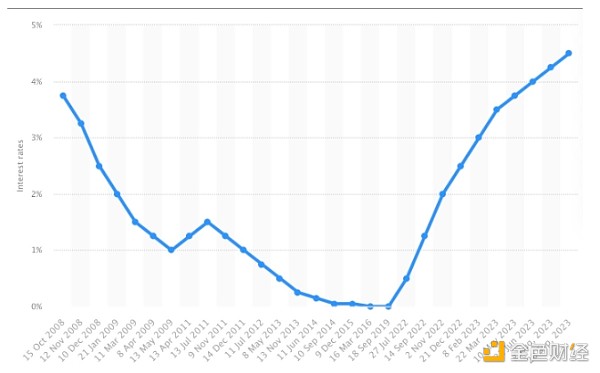Author: Jonathan Hargreaves, Global Growth Director of Web3 Ecosystem Elastos, CoinTelegraph; Compiler: Deng Tong, Golden Finance
BTC to The shift to Layer 2 solutions benefits every user. From supporting higher transaction speeds and volumes to enhancing security and enabling smart contracts directly within Bitcoin, L2’s technical advantages make it a significant development in the Bitcoin ecosystem.
However, the impact of Bitcoin L2 has the potential to extend far beyond technological improvements. The emergence of Bitcoin staking has been impossible to achieve so far, but its emergence is an important step towards the legalization and mainstreaming of cryptocurrency staking. In addition to creating value for currency holders, staking creates a new interest rate that is defined by users rather than central banks and Government policy decisions. This “people’s interest rate” offers an alternative to the flawed traditional interest rate system, and the ability to collateralize trusted and highly recognized assets enhances the viability and credibility of this vision Spend.
Essentially, The introduction of Bitcoin L2 means that Bitcoin transactions can now go through Layer 2 (or Data Link Layer) for transmission, rather than relying on the public Internet to transmit data, the correlation between data speed and packet transmission is guaranteed regardless of transaction volume.
From an end-user perspective, Complex smart contracts can now be developed and implemented directly in Bitcoin , contains all necessary conditions, dependencies and obligations - making Bitcoin not only a means of transaction, but also a means of compliance, ensuring the integrity of the contract.
Another benefit that Bitcoin L2 offers is staking, or the opportunity to earn interest or returns on the Bitcoin tokens you manage.
Flawed basic fee system
It is easy to understand why Bitcoin staking is "maxi" for Bitcoin ” Big news for the community – perhaps less obvious is the impact Bitcoin staking has on the broader economic landscape.
What mainstream fund managers, investors and central banks do with fiat currencies is stake them to make Bitcoin work. A country's base interest rate - the interest rate the central bank charges commercial banks for lending - nominally represents the opportunity cost of keeping money in a savings account rather than investing it elsewhere. Underpinning this view is the idea that interest returns offset inflation, which is itself affected by an economy's productivity and efficiency levels.

The European Central Bank (ECB) fixed interest rates from 2008-23. Source: Statista and European Central Bank.
As the economy develops, innovation enables companies to produce with the same or fewer resources more products, resulting in a decrease in the value of resources, including labor. Falling valuations are reflected in inflation, lowering real wage levels.
Theoretically, interest rates and inflation should cancel each other out, reflecting An increase in the productivity of an economy. In this way, savers are rewarded for borrowing money to finance innovations that increase productivity.
However, in fact, interest rates do not play such a role. Real interest rates in the world's major economies have remained at zero for the past decade. Europe’s benchmark interest rate remained below 1% between 2010 and 2020, and has been effectively zero since 2016. U.S. interest rates followed a similar trajectory until 2018, when they topped 1%.
This is good news for homeowners with mortgages, meaning lower mortgage interest payments and greater affordability. However, persistent low or zero real interest rates have complex effects on different groups of people and on the wider economy, and it is difficult to see how denying returns to those who are prudent enough to keep their money in the bank can be considered a good thing, Or fair policy.
The independence of a central bank depends on what the government allows, and since central bank governors themselves are appointed by the government, they are ultimately the implementers of policy - and false base rates are one of the consequences of this .
When considering the wider base rate landscape, what is evident is its disconnect from the underlying philosophy that underpins its fundamental utility. There is no correlation between interest rates and the opportunity cost of investment. Instead, the base rate risks becoming a political tool that officials can use expediently and opportunistically.
"Popular Rate"
Bitcoin staking offers an alternative. Just as fiat currencies can generate income in savings accounts, unspent Bitcoin can also earn rewards for participants. However, Different from the traditional financial system, the interest rate for Bitcoin pledges is determined by the users themselves, not by the central bank. Influenced by political agenda.
The more useful Bitcoin becomes (in terms of transaction volume and frequency, smart contract use cases and broader confidence in the currency), the higher Bitcoin rates will climb. The opposite is also true - a drop in confidence or the sudden emergence of more attractive alternatives will cause Bitcoin rates to fall. In this sense, the exchange rate behaves more like an exchange rate that favors the overall economy and generates a premium over other economies.
This possibility was already implicit in staking more generally, but Bitcoin’s place in the mainstream understanding of cryptocurrencies has raised the profile, importance and affordability of staking. And sex. The impact of Bitcoin L2 goes far beyond technical improvements, and the new structure brought about by Bitcoin staking should be of interest to everyone, not just those entrenched in the ecosystem.
Bitcoin staking is a fresh, decentralized alternative to the imperfect system that currently exists - enabling new rates to be defined by participants rather than lobbyists and government interests Possibly, becoming part of a better future for our economic system.
 JinseFinance
JinseFinance





